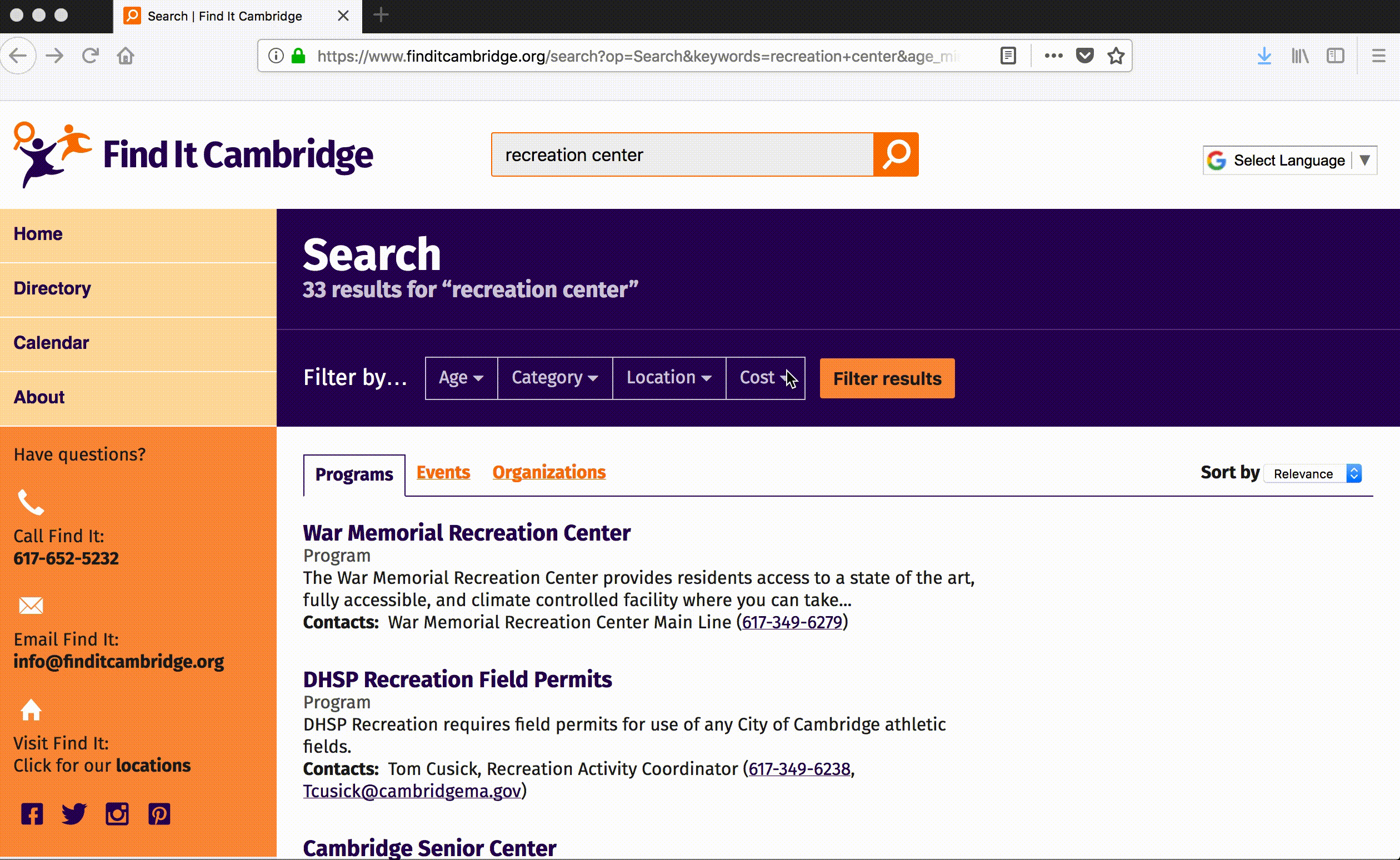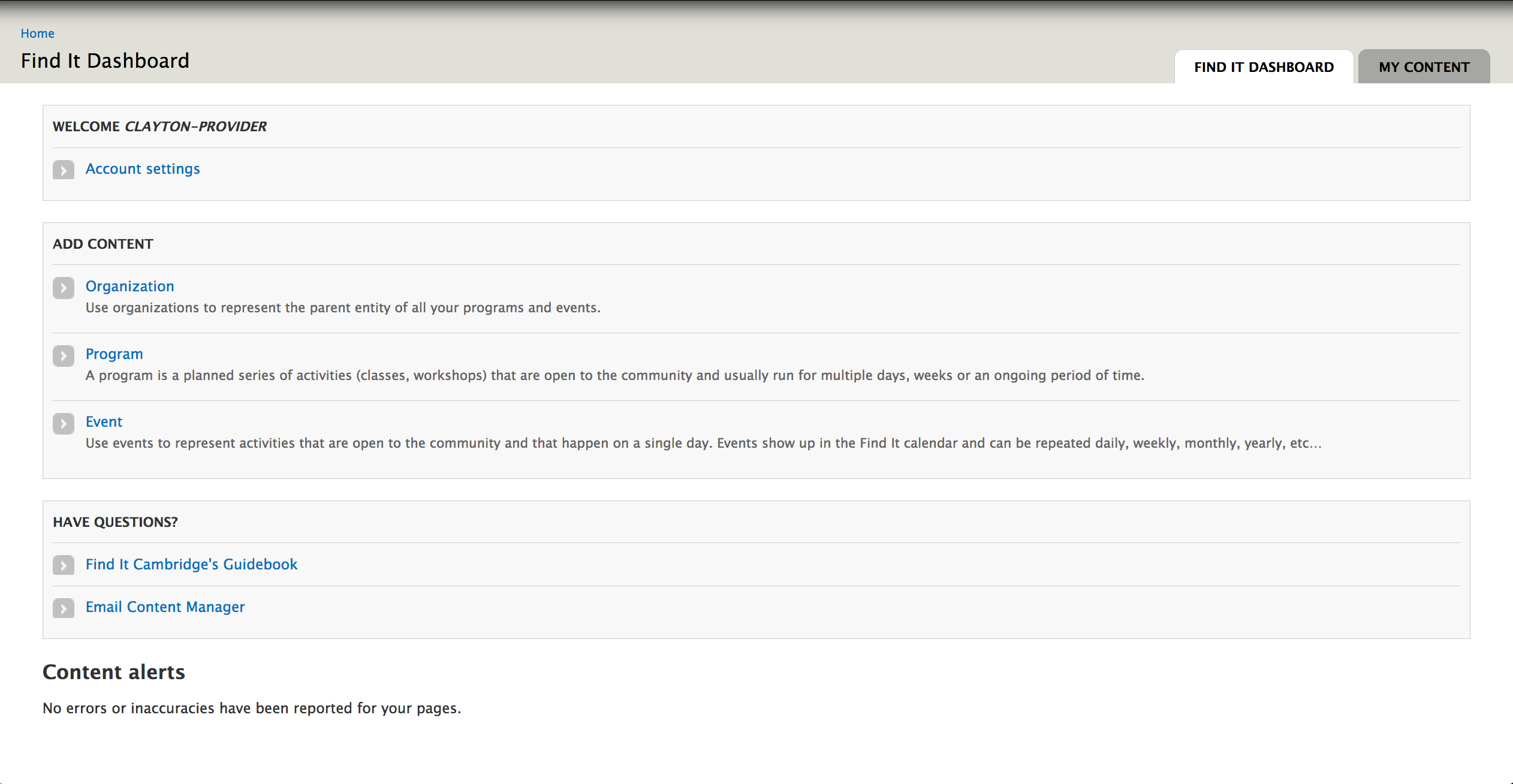
Drupal upgrades
Migrating content to your new site

After years of giving a terrible initial experience to people who want to share their first project on Drupal.org, the Project Applications Process Revamp is a Drupal Association key priority for the first part of 2017.
A plan for incentivizing code review of every project, not just new ones, after the project applications revamp is open for suggestions and feedback.
Which makes it excellent timing that right now you can get credit on your Drupal.org profile and that of your organization, boosting marketplace ranking, for reviewing the year-old backlog of project applications requesting review. The focus is on security review for these project applications, but if you want to give a thorough review and then give your thoughts on how project reviews (for any project that opts in to this quality marker) should be performed and rewarded going forward, now's the time and here's the pressing need.
For community shared business, development, and training tools, Agaric throws a little sponsorship at modulecraft.com.
2019 update: Pronovix let the domain expire, but the Wayback machine still has the content.
Create a user account
Set event reminders about interesting opportunities and receive notifications.
Find It websites help residents find all that their communities have to offer.
Cities and towns everywhere offer children and adults myriad programs, events, and places for enriching experiences. These activities and services come from various levels and agencies of government—operating schools, libraries, parks, and more—as well as from not-for-profit organizations, civic groups, private educational institutions, and others. However, any given person—say a single parent with three kids—has no time-efficient way of knowing about all of these opportunities.
Cambridge, Massachusetts, took on this problem. No software or website can solve this by itself, but an easily searchable directory with built-in reminders and tools to help keep it up to date makes finding all available opportunities achievable. Developed based on hundreds of hours of research and interviews led by the Cambridge Kids' Council, Find It Cambridge makes it easier for parents and other care-giving adults to find the amazing array of activities, services, and resources that are available for children, youth, and families in Cambridge.
This year, Agaric gave the site a major upgrade and made Find It capabilities freely available for other cities and towns.
If this is of interest to you for your city or region, especially if you work in an afterschool network or are otherwise in the thick of bringing opportunities to children, please get in touch by e-mail, at 1 508 283 3557, or through our contact form!
Sign up below to get (very) occasional updates.
Interested in Public Trainings?

Our relationship with technology is largely toxic- think Volkswagen cheating, Facebook spying, Uber being Uber. Tech is ruled by the elite and we are mostly at its mercy. As powerful movements have emerged challenging predatory power structures, let us do the same with technology.
Free/Open Source Software movements offer an alternative to corporate, predatory, proprietary technology. And yet Free Software still reflects many of these same oppressive relationships. One way to change that is with accountability.
Free Software means that anyone is free to read, use and remix the code that the software was written in. This helps with accountability because, unlike proprietary software, experts and community members can audit the code for security flaws and disingenuous functionality. However, there are several limitations with free software-
- Reviewing the code is only meaningful to coders.
- Changing the code or design can only be done by coders.
Only a small percentage of the world can code. An even smaller percentage have the time to write code for Free Software and an even smaller number have the time and expertise in any given project. This coder-centric framework also diminishes the many other skills essential to software: design, user research, project management, documentation, training, outreach to name a few.
As a major survey lead by GitHub supports (and comes as little surprise), the Free Software community is mostly white, male, cisgendered, financially well off, formally educated, able-bodied, straight, English speakers and citizens of Global North countries.
This means that the same groups of people designing and building proprietary software are also building Free Software. It means that despite its open licensing, the Free Software movement maintains the status quo of white supremacy, patriarchy and capitalism.
For Free Software to truly be free - to be free for anyone to build and use, we need to radically restructure our projects. It means building diverse communities where we are accountable to one another.
Many free software projects have already begun this work. Just a few examples-- Rust crafting and enforcing a thoughtful code of conduct, Ghost valuing design and user research throughout their work, Backdrop governing projects democratically and mentoring new contributors.
When we embody inclusion and accountability we grow vibrant communities building and using software that offers a clear alternative to the corporate, proprietary software; a software we can truly call free.

Saturday, February 2nd, 1:00 - 4 p.m.
Encuentro5 Community Space
9A Hamilton Place, Boston, MA 02108
encuentro5 (e5), DigBoston, UjimaBoston and Agaric Cooperative invite your participation in an important discussion on Technology and Revolution. The event is part of a series of discussions being held nationwide and coordinated by May First/People Link and the Center for Media Justice—leading up to an international convergence in Mexico City later this year.
Notable participants include: Alfredo Lopez, author, Puerto Rican independista, and co-director of May First/People Link; and Rajesh Kasturirangan, mathematician, cognitive scientist, and professor at the National Institute of Advanced Studies in India.
What is Our Response to the Rise of Tech Giants?
Over the last few decades, technological advances have not only radically changed methods of human communication but have also started to change humanity itself in ways that grassroots organizations on the political left have been slow to address. To the extent we have done so, it has been mostly to advocate for disenfranchised communities’ access to computers and broadband internet service.
But we have largely failed to grapple with issues beyond the rise of the internet and huge corporate social media platforms like Facebook and Twitter. And we’ve barely scratched the surface of those key changes, let alone put much thought into analyzing the effects of newer technologies like robotics, artificial intelligence, big data, and genetic engineering on our communities. This is all the more alarming because rapid technological has aggravated the inequalities about which the left has traditionally cared.
Nonetheless, social-change movements continuously emerge, often in unexpected spaces, but especially in artistic and youth spaces or from insurgent social movements of the oppressed and exploited. They create campaigns to challenge potentially negative technological developments and propose more helpful community-centered technologies in their place.
Questions We're Discussing
In the interest of promoting these movements and their just agendas, this gathering will convene organizers for an afternoon of sharing and thinking together. We will be sharing information and analyses about these topics in short, plain-spoken, manageable conversations. Our thinking together will be strategic, asking and answering straightforward questions:
- What are the most urgent and important challenges connected with technology?
- What are the key areas for intervention?
- Who are our allies?
- What are our resources?
- Before we can talk about joint and/or coordinated campaigns and targeting, what do we need?
More information at https://techandrev.org
Register
Today we complete the user migration example. In the previous post, we covered how to migrate email, timezone, username, password, and status. This time, we cover creation date, roles, and profile pictures. The source, destination, and dependencies configurations were explained already. Therefore, we are jumping straight to the process transformations in this entry.

Getting the code
You can get the full code example at https://github.com/dinarcon/ud_migrations The module to enable is UD users whose machine name is ud_migrations_users. The two migrations to execute are udm_user_pictures and udm_users. Notice that both migrations belong to the same module. Refer to this article to learn where the module should be placed.
The example assumes Drupal was installed using the standard installation profile. Particularly, we depend on a Picture (user_picture) image field attached to the user entity. The word in parenthesis represents the machine name of the image field.
The explanation below is only for the user migration. It depends on a file migration to get the profile pictures. One motivation to have two migrations is for the images to be deleted if the file migration is rolled back. Note that other techniques exist for migrating images without having to create a separate migration. We have covered two of them in the articles about subfields and constants and pseudofields.
Migrating user creation date
Have a look at the previous post for details on the source values. For reference, the user creation time is provided by the member_since column, and one of the values is April 4, 2014. The following snippet shows how the various user date related properties are set:
created:
plugin: format_date
source: member_since
from_format: 'F j, Y'
to_format: 'U'
changed: '@created'
access: '@created'
login: '@created'The created, entity property stores a UNIX timestamp of when the user was added to Drupal. The value itself is an integer number representing the number of seconds since the epoch. For example, 280299600 represents Sun, 19 Nov 1978 05:00:00 GMT. Kudos to the readers who knew this is Drupal's default expire HTTP header. Bonus points if you knew it was chosen in honor of someone’s birthdate. ;-)
Back to the migration, you need to transform the provided date from Month day, year format to a UNIX timestamp. To do this, you use the format_date plugin. The from_format is set to F j, Y which means your source date consists of:
- The full textual representation of a month:
April. - Followed by a space character.
- Followed by the day of the month without leading zeros:
4. - Followed by a comma and another space character.
- Followed by the full numeric representation of a year using four digits:
2014
If the value of from_format does not make sense, you are not alone. It is actually assembled from format characters of the date PHP function. When you need to specify the from and to formats, you basically need to look at the documentation and assemble a string that matches the desired date format. You need to pay close attention because upper and lowercase letters represent different things like Y and y for the year with four-digits versus two-digits respectively. Some date components have subtle variations like d and j for the day with or without leading zeros respectively. Also, take into account white spaces and date component separators. To finish the plugin configuration, you need to set the to_format configuration to something that produces a UNIX timestamp. If you look again at the documentation, you will see that U does the job.
The changed, access, and login entity properties are also dates in UNIX timestamp format. changed indicates when the user account was last updated. access indicates when the user last accessed the site. login indicated when the user last logged in. For brevity, the same value assigned to created is also assigned to these three entity properties. The at sign (@) means copy the value of a previous mapping in the process pipeline. If needed, each property can be set to a different value or left unassigned. None is actually required.
Migrating user roles
For reference, the roles are provided by the user_roles column, and one of the values is forum moderator, forum admin. It is a comma separated list of roles from the legacy system which need to be mapped to Drupal roles. It is possible that the user_roles column is not provided at all in the source. The following snippet shows how the roles are set:
roles:
- plugin: skip_on_empty
method: process
source: user_roles
- plugin: explode
delimiter: ','
- plugin: callback
callable: trim
- plugin: static_map
map:
'forum admin': administrator
'webmaster': administrator
default_value: nullFirst, the skip_on_empty plugin is used to skip the processing of the roles if the source column is missing. Then, the explode plugin is used to break the list into an array of strings representing the roles. Next, the callback plugin invokes the trim PHP function to remove any leading or trailing whitespace from the role names. Finally, the static_map plugin is used to manually map values from the legacy system to Drupal roles. All of these plugins have been explained previously. Refer to other articles in the series or the plugin documentation for details on how to use and configure them.
There are some things that are worth mentioning about migrating roles using this particular process pipeline. If the comma separated list includes spaces before or after the role name, you need to trim the value because the static map will perform an equality check. Having extraneous space characters will produce a mismatch.
Also, you do not need to map the anonymous or authenticated roles. Drupal users are assumed to be authenticated and cannot be anonymous. Any other role needs to be mapped manually to its machine name. You can find the machine name of any role in its edit page. In the example, only two out of four roles are mapped. Any role that is not found in the static map will be assigned the value null as indicated in the default_value configuration. After processing the null value will be ignored, and no role will be assigned. But you could use this feature to assign a default role in case the static map does not produce a match.
Migrating profile pictures
For reference, the profile picture is provided by the user_photo column, and one of the values is P01. This value corresponds to the unique identifier of one record in the udm_user_pictures file migration, which is part of the same demo module. It is important to note that the user_picture field is not a user entity property. The field is created by the standard installation profile and attached to the user entity. You can find its configuration in the “Manage fields” tab of the “Account settings” configuration page at /admin/config/people/accounts. The following snippet shows how profile pictures are set:
user_picture/target_id:
plugin: migration_lookup
migration: udm_user_pictures
source: user_photoImage fields are entity references. Their target_id property needs to be an integer number containing the file id (fid) of the image. This can be obtained using the migration_lookup plugin. Details on how to configure it can be found in this article. You could simply use user_picture as your field mapping because target_id is the default subfield and could be omitted. Also note that the alt subfield is not mapped. If present, its value will be used for the alternative text of the image. But if it is not specified, like in this example, Drupal will automatically generate an alternative text out of the username. An example value would be: Profile picture for user michele.
Technical note: The user entity contains other properties you can write to. For a list of available options, check the baseFieldDefinitions() method of the User class defining the entity. Note that more properties can be available up in the class hierarchy.
And with that, we wrap up the user migration example. We covered how to migrate a user’s mail, timezone, username, password, status, creation date, roles, and profile picture. Along the way, we presented various process plugins that had not been used previously in the series. We showed a couple of examples of process plugin chaining to make sure the migrated data is valid and in the format expected by Drupal.
What did you learn in today’s blog post? Did you know how to process dates for user entity properties? Have you migrated user roles before? Did you know how to import profile pictures? Please share your answers in the comments. Also, I would be grateful if you shared this blog post with others.
Next: Migrating dates into Drupal
This blog post series, cross-posted at UnderstandDrupal.com as well as here on Agaric.coop, is made possible thanks to these generous sponsors. Contact Understand Drupal if your organization would like to support this documentation project, whether it is the migration series or other topics.
Websites powered by Find It connect people to all that their communities have to offer. Developed under the guidance of the Cambridge Kids' Council, Find It ensures that people from all backgrounds can easily find activities, services, and resources.
Find It's design was informed by hundreds of hours of research, including over 1,250 resident surveys and over 120 interviews with service providers. Six years of research and development and continuous improvements has resulted in the Find It approach and platform, ready to be implemented in cities and communities around the world.
The platform is Free and Open-source and flexible so that communities can customize it to their own needs. Whether you are city IT staff, a developer that works with cities, or are anyone that could use a Find It in your community, we would love to talk.
Find It Cambridge is an online resource that empowers families, youth, and those who support them to easily find activities, services, and resources in Cambridge, Massachusetts. It serves as a one-stop-shop website for those who live and work in Cambridge.
Agaric led development and functionality-focused consulting on this project from its inception in 2016. In 2020, we upgraded the site and made the program locator and event finder platform that powers it available to all communities.
The Challenge
Building an event calendar and program directory central to people’s lives is challenging. City governments are notorious for silos and redundancy. The City of Cambridge was determined to do differently.
This started with thorough user research led by the city. Over 250 interviews and 1,250 surveys were completed by Cambridge residents and representatives from the city, schools, and community-based organizations. Taking the time to survey and interview everyday residents ensured we could confidently build a truly helpful site.
From that research we learned that the site needed:
- Powerful, but intuitive search for Cambridge residents
- Friendly authoring experience for service providers
- Phone number with a human on the other end
The Approach
To make the research findings a reality we combined forces with Terravoz, a digital research and development agency, and Todd Linkner, a designer and front-end developer who defined Find It Cambridge’s brand identity and developed an accompanying style guide.
A Search for Locals
There are hundreds of events, programs and organizations in Cambridge. To find exactly what one is looking for a sophisticated filtering system is a must. We chose Apache Solr, leader of the pack when it comes to advanced filtering.
One particularly interesting facet came out of Cambridge’s unique geography. Despite spanning a relatively small area, Cambridge’s neighborhood boundaries are infamously creative. Even longtime residents don’t necessarily know where one neighborhood ends and another starts. So, while filtering by neighborhood is helpful, we decided a visual aid was in order.
Todd Linkner created a custom SVG image file representing Cambridge’s neighborhoods. We then took that SVG file and wrote a custom module that associates each neighborhood map section to a Drupal vocabulary term. The result is a clickable map filter aiding site visitors in quickly finding programs and activities in their area.

A clickable map allows residents to filter by neighborhood.
Supporting Service Providers
For a knowledge hub like Find It Cambridge to thrive, it needed buy in from service providers. Getting their input during the research phase set that relationship off on the right foot. The resounding feedback was that the site needed to be easy for them to use.
This proved to be a challenge because while ease of use was critical, it was also essential that events and programs have rich metadata. The more data we ask of users, the more complex interfaces become.
To address this we leveraged Drupal’s customizable dashboard and the Field Groups module.
Customized Dashboard
By default, the first page a user sees when logging into a Drupal site is an underwhelming user profile page.
We customized a dashboard with the key actions providers take on the site: creating new content, updating past content and answering questions about the site.

A customized dashboard provides quick access to the most common tasks and information for service providers.
While there is a Drupal Dashboard module, we opted to build this ourselves for maximum flexibility and control. Doing so allowed us to break information out into several working tabs. A custom administrative page for internal documentation pages and other Find It Cambridge information turns control over the “Have Questions?” section of the dashboard over to site administrators, rather than being hardcoded.
Delete Without Worries
With dozens of service providers managing content on the site mistakes are bound to happen. The worst scenario is accidentally deleting a node. In Drupal when a node is deleted it is gone forever. To protect against these we used the Killfile module to “soft delete” nodes, allowing for their recovery if needed.
Helping Managers Help Providers
Another key piece to getting relevant, timely information added to the site is helping the Find It Cambridge team remind and support service providers to use the site and update their information. To that end we put together a statistics page listing organizations in alphabetical order, along with the number of programs and events they have. This allows the team to quickly spot duplicate entries and other incorrect data.
We also implemented a notification system. Any time a service provider adds or updates content the Find It team receives an email. This helps managers stay on top of the ever changing content of the site.
Results
Since Find It Cambridge launched, 333 organizations have created accounts and contributed to the directory. Residents now have a single site they can refer to stay connected with events and access programs. The effort has also fostered increased collaboration across city departments and services.
Connecting community is an ongoing process and we continue to improve the site to better connect residents.
In 2020, we completely overhauled the site and built the program locator and event finder that powers FindItCambridge as software and as a platform available to all cities, towns, and regions to adopt.
Sign up to be notified when Agaric gives a migration training:
Somos Agaric, una cooperativa de trabajadores. Construimos sitios web y herramientas en línea que respetan tu libertad. Brindamos capacitación y consulta para alcanzar sus metas.
Descubra cómo Agaric puede ayudarlo a ganar poder sobre su tecnología en línea.
Pagination
- Previous page
- Page 14

